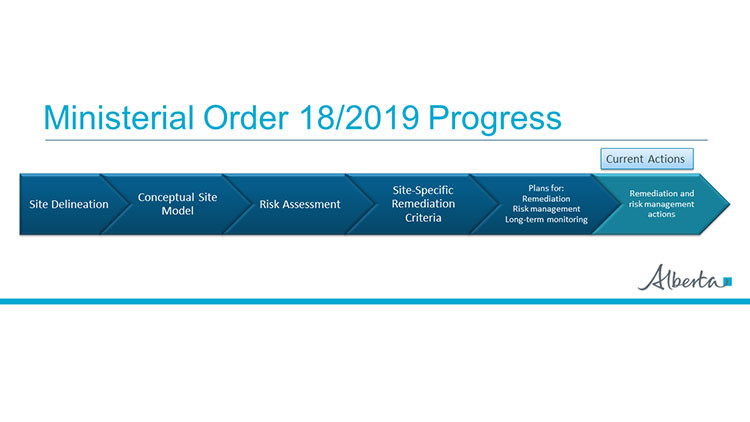Non-urgent government operations are closed December 24 to January 1, reopening January 2. View available services during this period.
Project update
November 15, 2023
The Ministerial Order from March 12, 2019 outlines requirements for Cherokee Canada Inc., 1510837 Alberta Ltd. and Domtar Inc., related to the former Domtar site (44th Street and 127th Avenue, Edmonton, Alberta).
The Ministerial Order indicates the companies must submit work plans and complete remedial work within the communities and on the former property within specified periods to protect environmental and human health and ensure effective remediation.
The government has completed a review of the required site assessments and risk assessments and completed the determination of the site-specific remediation criteria, as required by the Ministerial Order. For the site-specific remediation criteria decision, read:
The Office of the Chief Scientist provided a peer review of the site-specific remediation criteria decision by completing an independent, external scientific review of relevant information considered in the department’s site-specific remediation criteria decision under the Ministerial Order.
Using these site-specific remediation criteria, Domtar and Cherokee have created remediation and risk management plans to address the identified contamination. Remediation plans are applicable to Parcel Y (the former Domtar facility), and risk management plans and long-term monitoring plans are applicable to the berm and greenspace along the CN railway (Parcel X, Parcel C berm, Parcel Y berm and the greenbelt behind the Overlanders community).
The government will ensure that all approved plans and activities on the site meet the applicable site-specific and provincial standards for the protection of human and environmental health and that the required properties are remediated to the applicable site-specific and provincial standards. Remediation is not expected or required within the Verte Homesteader community or the Overlanders community.
The department has approved the remediation, risk management and long-term monitoring plans for Cherokee. Remediation work started in the fall of 2022 on Parcel Y and was completed in November 2023. The department approved the risk management and long-term monitoring plans for Domtar in the fall of 2022. These plans enable long-term monitoring to begin on the lands along the railway in 2023.
Next steps
Remediation and reclamation
Excavation of contaminated soils from the area of the former wood-preserving facility intended for residential development has been completed and deemed acceptable by the Department in November 2023. Decisions related to the type and timing of redevelopment of the land are under the jurisdiction of the City of Edmonton now that remediation is complete.
Risk management and long-term monitoring
Risk management of residual contamination is allowed if the contamination can be managed in place without causing adverse effects to human health or the environment. At this site, management of contamination below the recreational areas of the bermed soils and the greenbelt areas is considered possible without causing adverse effect.
Engineering controls, such as separation between surface soils and contaminated soils, as well as administrative controls to ensure that soil is not disturbed without proper oversight, are being used.
During implementation of the risk management plans, field personnel will access monitoring wells at various times over the coming years on the berm and greenbelt areas. Groundwater and soil vapour samples will be collected and analyzed to provide assurance that risks are properly managed.
If the sampling indicates unexpected concentrations of contaminants, the risk management plan requires corrective actions before there is an exposure concern.
About the 2019 Ministerial Order
The Ministerial Order, based on recommendations from the Environmental Appeals Board, refocused the department’s management of the former Domtar wood preserving facility and issues in neighbouring communities. Above all, the concerns for the health and welfare of local residents remains paramount for government. The order – and accompanying environmental protection orders – clearly stated the need to protect human and environmental health.
The Ministerial Order also directed the companies to provide activity updates directly to residents every 2 months. Once reports are accepted in final format by the Department, summaries of reports and access to reports will be made available by the companies through their community websites.
For Albertans seeking specific information on the Ministerial Order and accompanying environmental protection orders, read the Alberta EAB Report and Recommendations – February 26, 2019.
Timeline on progress
The figure below outlines the current state of progress within the Ministerial Order.

In our commitment to keep residents updated on progress, the Alberta government will be maintaining an action item timeline below as milestones (as set by the order and represented in the figure above) are reached.
Action items from Ministerial Order
| Action Item | Cherokee Status | Domtar Status |
|---|---|---|
| Short term dust control plan | Received; no approval required | Received; no approval required |
| Long-term dust control program | Approved | Approved |
| Delineation plan | Approved | Approved |
| Site Delineation | Received – To Be Updated Based on Field Work in 2023 | Approved |
| Conceptual Site Modelling | Received – To Be Updated Based on Field Work in 2023 | Approved |
| Site Specific Risk Assessment | Approved | Approved |
| Human Health Risk Assessment | Approved | Approved |
| Overlanders Remediation Plan | Not Applicable | Not required |
| Parcel C Remediation Plan | Approved with no further action required. | Not Applicable |
| Risk Management Plan | Approved | Approved |
| Long Term Monitoring Plan | Approved | Approved |
| Reclamation and Remediation Plan | Approved – pending completion in Parcel Y | Not required |
As announced in March 2019, Alberta Health continues to work with federal experts to conduct a field epidemiology investigation.